Assessing the Long-Term Production of Suspended Sediment and the Climate Changes Impact on Its Deposition in Artificial Lakes—A Case Study of Lake Trakošćan, Croatia
Abstract
1. Introduction
- Exploring landscape processes with a particular focus on changes in vegetation and catchment land use during the observed period;
- An analysis of meteorological and hydrological data and calculating the trends in the period of 1961–2020 to define the influences of climate changes on sediment production;
- Calculation of the annual sediment production in the catchment by parametric methods and comparing the results with previous studies as well as the measured sediment transport values in Bednja River;
- Calculating the sediment deposition time in Trakošćan Lake for future management activities.
2. Materials and Methods
2.1. Study Area
2.2. Meteorological and Hydrological Data
2.3. CORINE LAND Cover Data
2.4. Methods
2.4.1. G. Fleming’s Method for Average Annual Sediment Production
2.4.2. G.M. Brune’s Empirical Method for Sediment Deposition Time in Reservoirs
- The amount of sediment introduced into the reservoir;
- The amount of sediment retained in the lake;
- The density of the deposited sediment.
3. Results
3.1. Homogeneity and Trend Analysis
3.2. Corine Land Cover Analysis
3.3. Sediment Production
4. Discussion
4.1. Contribution from the Previous Project
4.2. Results from This Investigation
- Construction works that were carried out in 1980 in the Trakošćan lake basin and the impact of barriers on reducing the input of sediment carried by torrents into the lake;
4.3. Future Research Directions
- Preventing sediment transport from the torrents and the deposition of organic and inorganic materials in the lake, which significantly reduces the water quality.
- 2.
- Improvement of methods for calculating sediment production and forecasting the time of its deposition in the lake to plan procedures for the effective operational management of the Trakošćan basin.
- 3.
- For better and permanent monitoring of all meteorological, hydrological, geological, chemical, and biological processes, it is necessary to define Lake Trakošćan as an experimental catchment.
5. Conclusions
Author Contributions
Funding
Acknowledgments
Conflicts of Interest
References
- Old, G.; Lofts, S. (Eds.) Integrated Sediment Management: Guidelines and Good Practices in the Context of the Water Framework Directive [Draft]; 2022; Available online: https://environment.ec.europa.eu/system/files/2022-09/CISdocumentsedimentfinalTO_BE_PUBLISHED_1430554724.pdf (accessed on 22 April 2023).
- Hrnjica, B.; Bonacci, O. Lake Level Prediction using Feed Forward and Recurrent Neural Networks. Water Resour. Manag. 2019, 33, 2471–2484. [Google Scholar] [CrossRef]
- Beniston, M. Impacts of climatic change on water and associated economic activities in the Swiss Alps. J. Hydrol. 2012, 412–413, 291–296. [Google Scholar] [CrossRef]
- Stefanidis, P.; Stefanidis, S.; Tziaftani, F. The threat of alluviation of lakes resulting from torrents (case study: Lake volvi, North Greece). Int. J. Sustain. Dev. Plan. 2011, 6, 325–335. [Google Scholar] [CrossRef][Green Version]
- Stefanidis, S.; Chatzichristaki, C. Response of soil erosion in a mountainous catchment to temperature and precipitation trends. Carpathian J. Earth Environ. Sci. 2017, 12, 35–39. [Google Scholar]
- Jain, S.K.; Singh, P.; Seth, S.M. Assessment of sedimentation in Bhakra Reservoir in the western Himalayan region using remotely sensed data. Hydrol. Sci. J. 2002, 47, 203–212. [Google Scholar] [CrossRef]
- Issa, I.E.; Al-Ansari, N.; Sherwany, G.; Knutsson, S. Sedimentation Processes and Useful Life of Mosul Dam Reservoir, Iraq. Engineering 2013, 5, 779–784. [Google Scholar] [CrossRef]
- Hrissanthou, V. Comparative application of two mathematical models to predict sedimentation in Yermasoyia Reservoir, Cyprus. Hydrol. Process. 2006, 20, 3939–3952. [Google Scholar] [CrossRef]
- Martin, S.E.; Conklin, M.H.; Bales, R.C. Seasonal accumulation and depletion of local sediment stores of four headwater catchments. Water 2014, 6, 2144–2163. [Google Scholar] [CrossRef]
- Hrvatske Vode Zagreb. Vodnogospodarski Odjel za Vodno Područje Sliva Drave i Dunava Osijek—Vodnogospodarski odsjek Varaždin. In Stanje Trakošćanskog Jezera i Pripadajućih Bujica koje se Ulijevaju u Jezero, pr. Number: 447/98; Hrvatske Vode: Varaždin, Croatia, 1998. [Google Scholar]
- Kerovec, M.; Ternjej, I.; Plenković-Moraj, A.; Hršak, V.; Mihaljević, Z.; Gottstein, S.; Lajtner, J.; Popijač, A.; Gligora, M.; Žganec, K.; et al. Study of Determining the State of Water in Lake Trakošćan with an Assessment of Measures for Rehabilitation and Revitalisation; University of Zagreb, Faculty of Science, Department of Biology: Zagreb, Croatia, 2007. [Google Scholar]
- Geokon, D.D. Geotechnical Study of a Survey of the Thickness and Composition of Sediment and Water Quality in Lake Trakošćan; Geokon-Zagreb d.d.: Zagreb, Croatia, 2019. [Google Scholar]
- Leskovar, K.; Mrakužić, P.; Meaški, H. Evaluation of remotely sensed precipitation product in a hydrological model of the Bednja watershed. Gradjevinar 2021, 73, 335–348. [Google Scholar] [CrossRef]
- Šimunić, A.N.; Pikija, M.; Hećimović, I. Basic Geological Map of Croatia 1:100 000—Sheet Varaždin; Croatian Geological Survey: Zagreb, Croatia, 1982. [Google Scholar]
- Dragičević, I.; Blašković, I.; Mayer, D.; Žugaj, R.; Tomljenović, B. Gorski i Prigorski Vodonosnici Sjeverne Hrvatske (Izvješće o Radovima u 1996. Godini); Fond Struĉne Dokumentacije RGNF: Zagreb, Croatia, 1997. [Google Scholar]
- DHMZ. Croatian Meteorological and Hydrological Service. Available online: https://meteo.hr/index_en.php (accessed on 22 April 2023).
- Oskoruš, D. Contribution to the Analysis of Suspended Load Dynamics in the Transfer Zone of the River Sava; Faculty of Civil Engineering, University of Zagreb: Zagreb, Croatia, 2015. [Google Scholar]
- Pandžić, K.; Kobold, M.; Oskoruš, D.; Biondić, B.; Biondić, R.; Bonacci, O.; Likso, T.; Curić, O. Standard normal homogeneity test as a tool to detect change points in climate-related river discharge variation: Case study of the Kupa River Basin. Hydrol. Sci. J. 2020, 65, 227–241. [Google Scholar] [CrossRef]
- Gibbons, J.D.; Chakraborti, S. Nonparametric Statistical Inference; Chapman and Hall/CRC: Boca Raton, FL, USA, 2010; ISBN 9781439896129. [Google Scholar]
- Mann, H.B. Nonparametric Tests against Trend. Econometrica 1945, 13, 245. [Google Scholar] [CrossRef]
- Kendall, M.; Gibbons, J. Rank Correlation Methods—Charles Griffin Book, 5th ed.; Oxford University Press: London, UK, 1990; ISBN 0195208374. [Google Scholar]
- CORINE Land Cover—Copernicus Land Monitoring Service. Available online: https://land.copernicus.eu/pan-european/corine-land-cover (accessed on 11 September 2018).
- Asselman, N.E.M. The impact of climate change on suspended sediment transport in the river Rhine. Stud. Environ. Sci. 1995, 65, 937–942. [Google Scholar] [CrossRef]
- Cheng, N.N.; He, H.M.; Yang, S.Y.; Lu, Y.J.; Jing, Z.W. Impacts of topography on sediment discharge in Loess Plateau, China. Quat. Int. 2017, 440, 119–129. [Google Scholar] [CrossRef]
- Dwarakish, G.S.; Ganasri, B.P. Impact of land use change on hydrological systems: A review of current modeling approaches. Cogent Geosci. 2015, 1, 1115691. [Google Scholar] [CrossRef]
- Stonestrom, D.A.; Scanlon, B.R.; Zhang, L. Introduction to special section on Impacts of Land Use Change on Water Resources. Water Resour. Res. 2009, 45. [Google Scholar] [CrossRef]
- Mao, D.; Cherkauer, K.A. Impacts of land-use change on hydrologic responses in the Great Lakes region. J. Hydrol. 2009, 374, 71–82. [Google Scholar] [CrossRef]
- Fleming, G. Design Curves for Suspended Load Estimation. Proc. Inst. Civ. Eng. 1969, 43, 1–9. [Google Scholar] [CrossRef]
- Te Chow, V.; Maidment, D.R.; Mays, L.W. Applied Hydrology; McGraw-Hill: New York, NY, USA, 1988; Volume 6. [Google Scholar]
- Brune, G.M. Trap efficiency of reservoirs. Trans. Am. Geophys. Union 1953, 34, 407. [Google Scholar] [CrossRef]
- Gentilucci, M.; Djouohou, S.I.; Barbieri, M.; Hamed, Y.; Pambianchi, G. Trend Analysis of Streamflows in Relation to Precipitation: A Case Study in Central Italy. Water 2023, 15, 1586. [Google Scholar] [CrossRef]
- Matoušková, M.; Fraindová, K. Trends of hydroclimatic variables and outflow in the Athabasca River basin. Geogr. CGS 2023, 128, 127–152. [Google Scholar] [CrossRef]
- Hidroplan, d.o.o. Cleaning of Trakošćan Reservoir from Accumulated Sediment—Implementation Project; Hidroplan d.o.o.: Zagreb, Croatia, 2020. [Google Scholar]
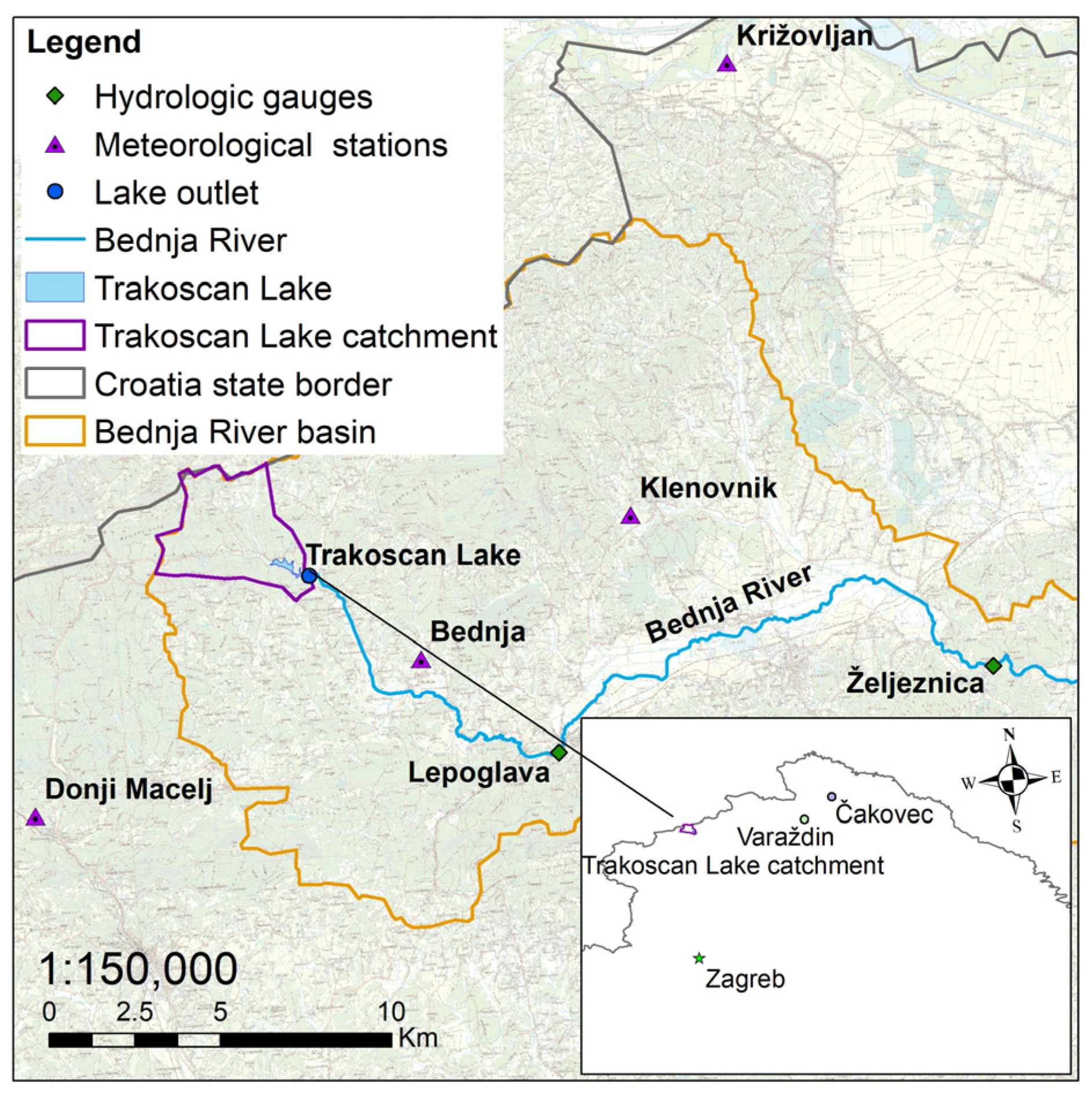

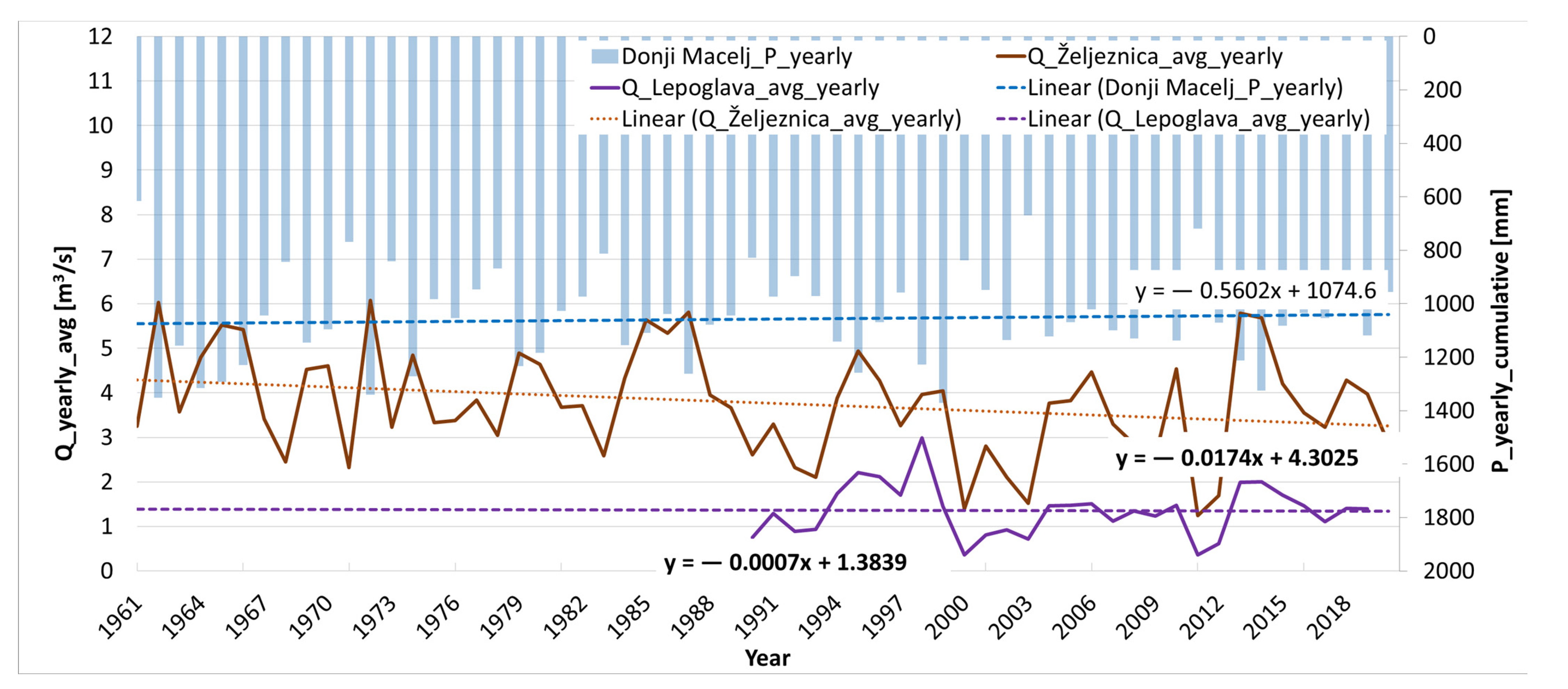
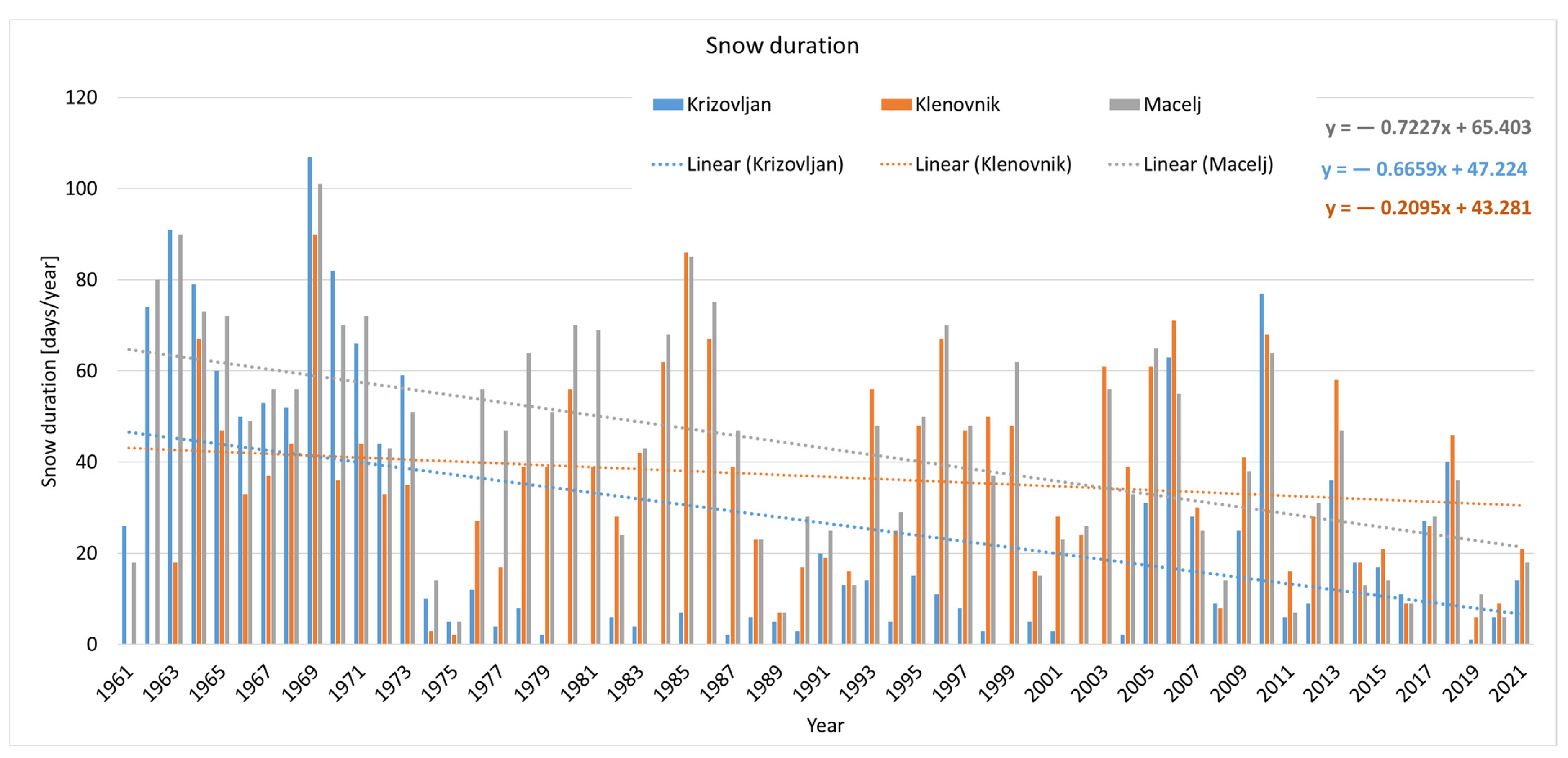
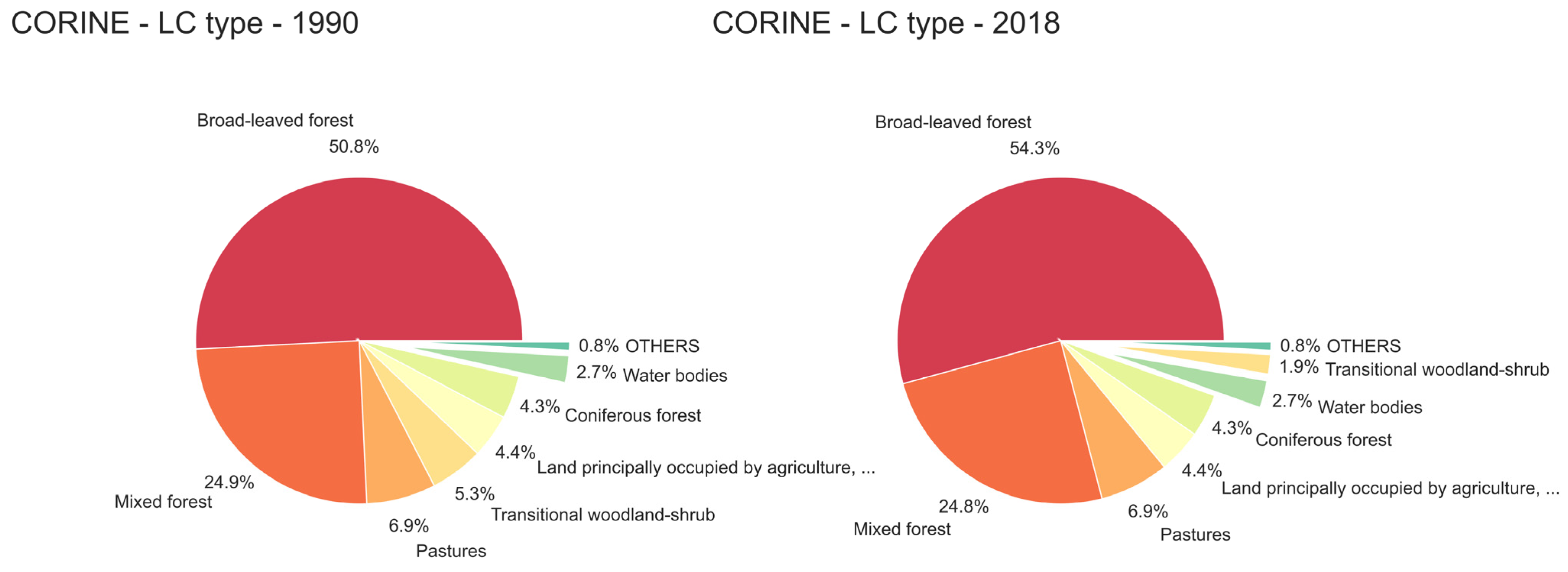
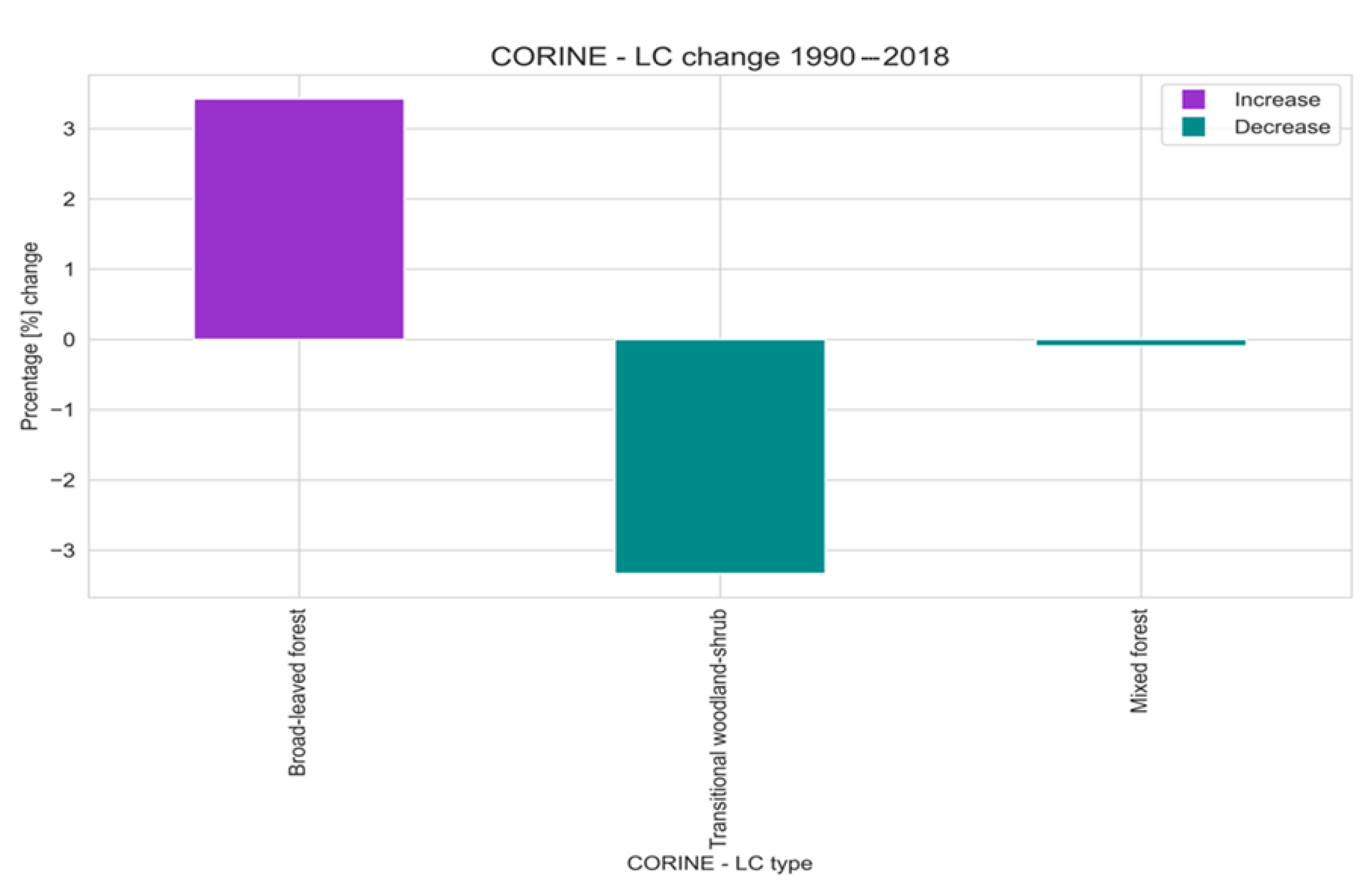

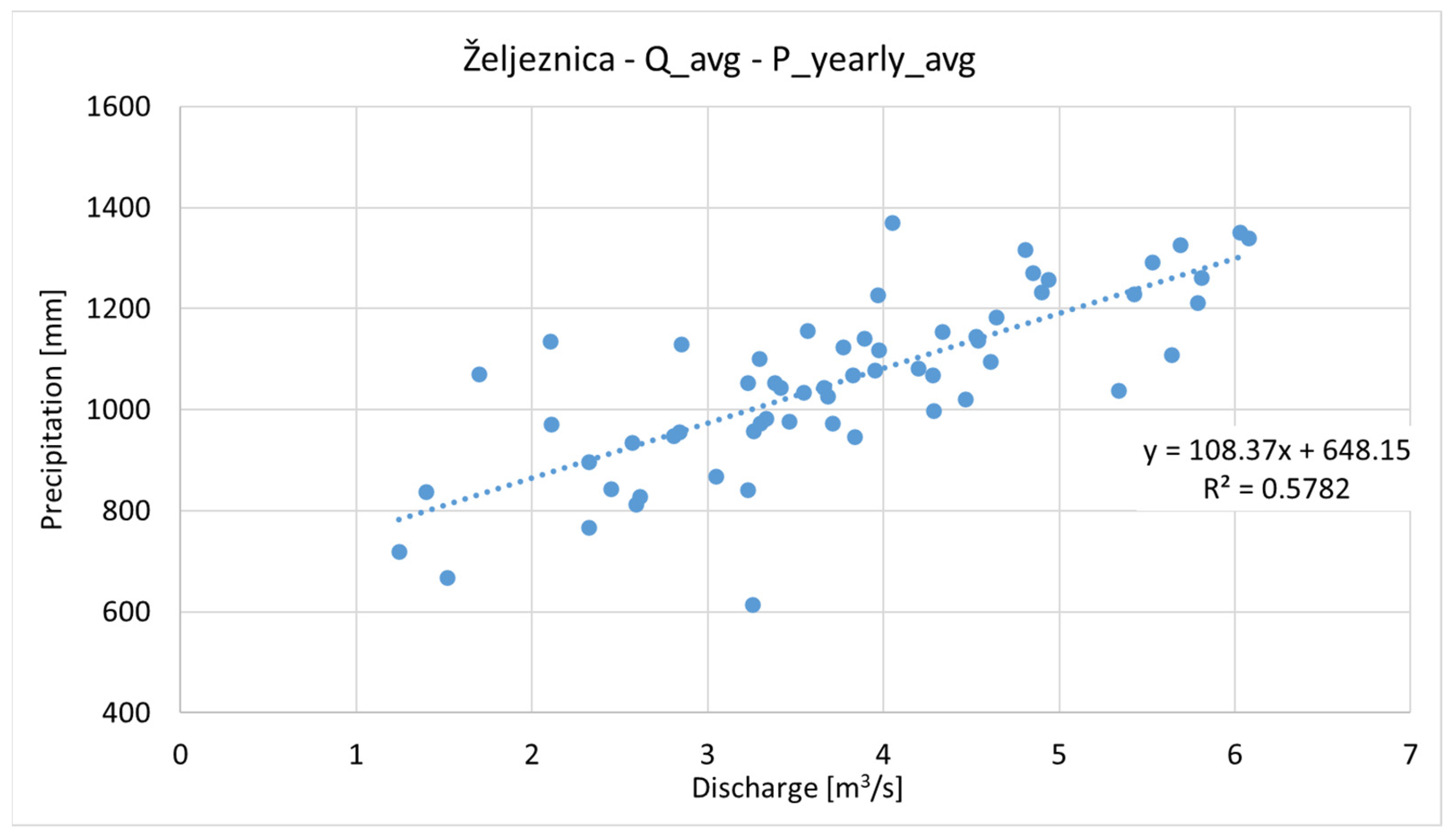
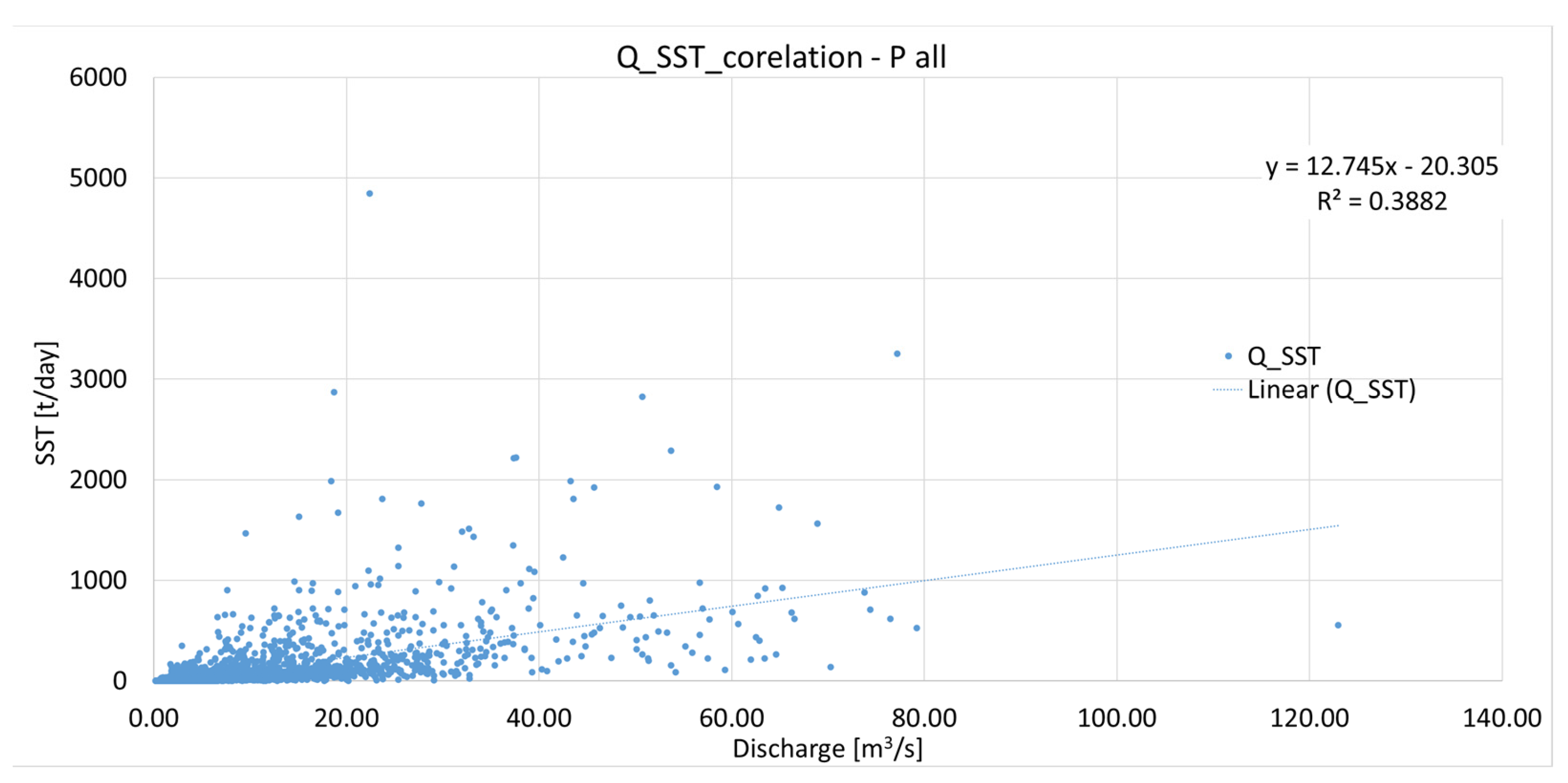
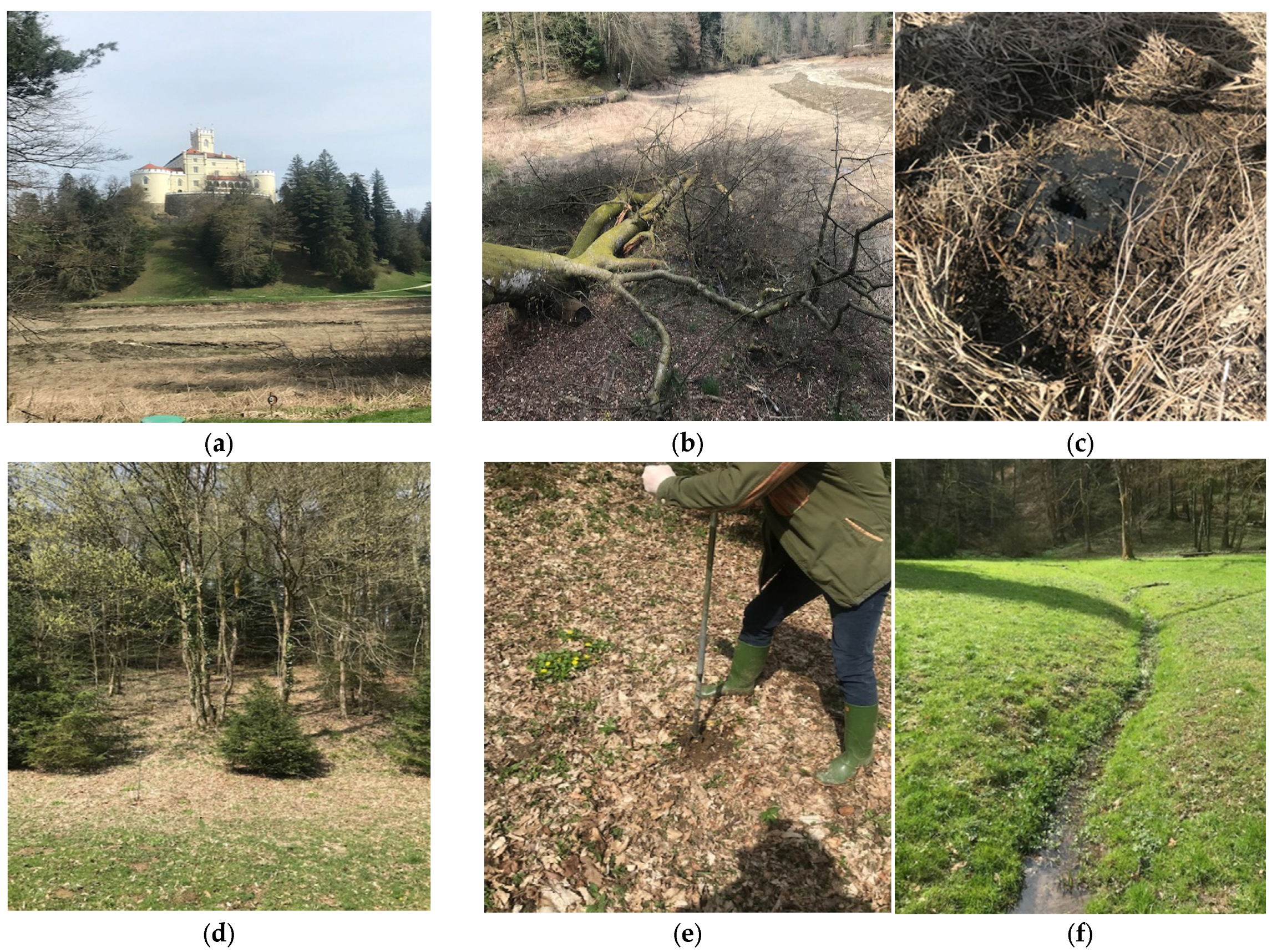
| Data Type | Data Source | No. Stations | Timestep | St. name/Elevation (m a.s.l.) | Station Latitude/Longitude |
|---|---|---|---|---|---|
| Meteorological | |||||
| precipitation [mm] snow depth [cm] | DHMZ | 4 | daily | Donji Macelj (208 m), Bednja (240 m), Klenovnik (230 m) Križovljan (199 m) | 46.200/15.833 |
| 46.233/15.983 | |||||
| 46.267/16.067 | |||||
| 46.383/16.117 | |||||
| Hydrological | |||||
| discharge [m3/s] suspended sediment concentration [g/m3] suspended sediment transport [t/day] | DHMZ | 2 | daily | Lepoglava (219 m), Željeznica (197 m) | |
| 46.207/16.034 | |||||
| 46.220/16.200 |
| Meteorological | Data Period | Mean | Std | Min | 25% | 50% | 75% | Max |
|---|---|---|---|---|---|---|---|---|
| Bednja precip [mm/day] | 2006–2021 | 2.896 | 7.497 | 0 | 0 | 0 | 1.1 | 80 |
| Donji Macelj precip [mm/day] | 1962–2021 | 2.916 | 7.455 | 0 | 0 | 0 | 1.1 | 110.4 |
| Klenovnik precip [mm/day] | 1962–2021 | 3.019 | 7.719 | 0 | 0 | 0 | 1.2 | 103.9 |
| Križovljan grad precip [mm/day] | 1961–2021 | 2.530 | 6.354 | 0 | 0 | 0 | 1 | 99.2 |
| Hydrological | ||||||||
| Željeznica discharge [m3/s] | 1961–2021 | 3.770 | 6.177 | 0.2 | 0.98 | 1.83 | 3.71 | 123 |
| Željeznica SSC [g/m3] | 1987–2021 | 28.664 | 78.024 | 0 | 4.94 | 9.62 | 20.35 | 2503 |
| Željeznica SST [t/day] | 1987–2021 | 24.006 | 125.887 | 0 | 0.432 | 1.17 | 5.03 | 4848 |
| Station | Original Series | Modified Series | p-Value | Homogeneity |
|---|---|---|---|---|
| Donji Macelj | 1962–2021 | 1987–2021 | 0.401 | Yes |
| Klenovnik | 1963–2021 | 1987–2021 | 0.763 | Yes |
| Križovljan grad | 1962–2021 | 1987–2021 | 0.719 | Yes |
| Station | Original Series | Modified Series | p-Value | Homogeneity |
|---|---|---|---|---|
| Donji Macelj | 1962–2021 | 1987–2021 | 2.18 × 10−5 | No |
| Klenovnik | 1963–2021 | 1987–2021 | 0.192 | Yes |
| Križovljan grad | 1962–2021 | 1987–2021 | 0.179 | Yes |
| Vegetation Cover | n | a |
|---|---|---|
| mixed deciduous and coniferous forests | 1.02 | 4.000 |
| coniferous forests and tall grass | 0.82 | 59.000 |
| short grass and bushes | 0.65 | 177.000 |
| desert and bush | 0.72 | 446.000 |
| Type of Deposit | Constantly Immersed | WITH AIR |
|---|---|---|
| ρs′ (kg/m3) | ρs″ (kg/m3) | |
| Clay | 640–960 | 960–1280 |
| Mud, silt | 880–1200 | 1200–1360 |
| Sand | 1360–1600 | 1360–1600 |
| Weakly granulated sand and gravel | 1520–2080 | 1520–2080 |
| Curve | a | n |
|---|---|---|
| Upper envelope | 130 | 1.0 |
| Mean curve | 100 | 1.5 |
| Lower envelope | 65 | 2.0 |
| Križovljan | Klenovnik | Donji Macelj_1962 | Donji Macelj_1988 | |
|---|---|---|---|---|
| trend | Decreasing * | no trend | no trend | no trend |
| h | TRUE * | FALSE | FALSE | FALSE |
| p | 0.032120712 | 0.236174983 | 0.170854822 | 0.218182155 |
| z | −2.142905193 | −1.184601653 | −1.369462266 | −1.231376304 |
| Tau | −0.201257862 | −0.106370544 | −0.193846154 | −0.14973262 |
| s | −288 | −182 | −63 | −84 |
| var_s | 17937.33333 | 23346 | 2049.666667 | 4543.333333 |
| Sen_slope | −0.333333333 | −0.230769231 | −0.545454545 | −0.421052632 |
| intercept | 23.66666667 | 43.15384615 | 66.81818182 | 34.94736842 |
| Donji Macelj | Klenovnik | Križovljan | |
|---|---|---|---|
| trend | no trend | no trend | no trend |
| h | FALSE | FALSE | FALSE |
| p | 0.341043251 | 0.96438843 | 0.244551669 |
| z | −0.952105952 | 0.044647312 | 1.163685053 |
| Tau | −0.084153005 | 0.004519774 | 0.10273224 |
| s | −154 | 8 | 188 |
| var_s | 25,823.33333 | 24,581.33333 | 25,823.33333 |
| Sen_slope | −1.063383838 | 0.030553724 | 2.006666667 |
| intercept | 1101.201515 | 1068.468111 | 842 |
| Catchment Area | Lake Volume | Annual Precipitation | Runoff Coefficient |
|---|---|---|---|
| A (km2) | V0 (m3) | P (mm) | c (-) |
| 10.7 | 4.00 × 105 | 983 | 0.38 |
| Sediment Production | Sediment Density | Inflow of Effective Precipitation | Sediment Volume | Free Volume of the Lake | Brune’s Coefficients | |
|---|---|---|---|---|---|---|
| G (kg/year) | ρs′ (kg/m3) | Q (m3/year) | Vn (m3/year) | Va′ (m3) | a | n |
| 8.65 × 105 | 900 | 4.00 × 106 | 9.61 × 102 | 5.00 × 104 | 100 | 1.5 |
| Segment | Average Segment Volume | X | Y | Filling Time |
|---|---|---|---|---|
| Va (105 m3) | Vi (105 m3) | - | - | t (years) |
| 3.5–4 | 3.75 | 0.0938 | 0.8591 | 60.6 |
| 3–3.5 | 3.25 | 0.0813 | 0.8403 | 61.9 |
| 2.5–3 | 2.75 | 0.0688 | 0.8158 | 63.8 |
| 2–2.5 | 2.25 | 0.0563 | 0.7825 | 66.5 |
| Total time: | 253 |
| Torrent Name | Torrent Catchment Area [km2] | Torrent Length [km′] | Conceptual Solution from 1989 [m3] | Projected Landfill Volume [m3] |
|---|---|---|---|---|
| Čemernica with tributaries 1–6 | 6.22 | 2.76 1.22 | 4894 | 3155 600 |
| Torrents of the southern part of Trakošćan Lake (1–9) | 1.217 | 3.25 | 2340 | 3800 |
| Torrents of the northern part of Trakošćan Lake (10–13) | 3.527 | 4.00 | 2766 | --- |
| TOTAL | 10.964 | 11.23 | 10,000 | 7415 |
| Sediment Production-FLEMING [t/year] | Increase of 50% [t/year] | Sediment Volume [m3] | Specific Sediment Production–Basin Wide [t/year/km2] | Specific Sediment Volume [m3/year/km2] |
|---|---|---|---|---|
| 775 | 1162 | 646 | 111 | 61 |
Disclaimer/Publisher’s Note: The statements, opinions and data contained in all publications are solely those of the individual author(s) and contributor(s) and not of MDPI and/or the editor(s). MDPI and/or the editor(s) disclaim responsibility for any injury to people or property resulting from any ideas, methods, instructions or products referred to in the content. |
© 2023 by the authors. Licensee MDPI, Basel, Switzerland. This article is an open access article distributed under the terms and conditions of the Creative Commons Attribution (CC BY) license (https://creativecommons.org/licenses/by/4.0/).
Share and Cite
Oskoruš, D.; Leskovar, K.; Pavlić, K.; Tošić, I. Assessing the Long-Term Production of Suspended Sediment and the Climate Changes Impact on Its Deposition in Artificial Lakes—A Case Study of Lake Trakošćan, Croatia. Climate 2023, 11, 167. https://doi.org/10.3390/cli11080167
Oskoruš D, Leskovar K, Pavlić K, Tošić I. Assessing the Long-Term Production of Suspended Sediment and the Climate Changes Impact on Its Deposition in Artificial Lakes—A Case Study of Lake Trakošćan, Croatia. Climate. 2023; 11(8):167. https://doi.org/10.3390/cli11080167
Chicago/Turabian StyleOskoruš, Dijana, Karlo Leskovar, Krešimir Pavlić, and Igor Tošić. 2023. "Assessing the Long-Term Production of Suspended Sediment and the Climate Changes Impact on Its Deposition in Artificial Lakes—A Case Study of Lake Trakošćan, Croatia" Climate 11, no. 8: 167. https://doi.org/10.3390/cli11080167
APA StyleOskoruš, D., Leskovar, K., Pavlić, K., & Tošić, I. (2023). Assessing the Long-Term Production of Suspended Sediment and the Climate Changes Impact on Its Deposition in Artificial Lakes—A Case Study of Lake Trakošćan, Croatia. Climate, 11(8), 167. https://doi.org/10.3390/cli11080167









